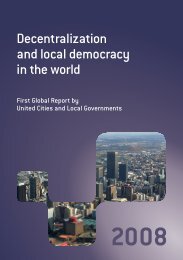Making Cities Resilient Report 2012
Making Cities Resilient Report 2012
Making Cities Resilient Report 2012
You also want an ePaper? Increase the reach of your titles
YUMPU automatically turns print PDFs into web optimized ePapers that Google loves.
CONCLUSIONS OF THE REPORT<br />
No city begins with all the political, technical or financial resources it wants; and no (or few) local<br />
government count on ‘perfect institutions,’ yet all the cities reviewed in this report were able to leverage<br />
the resources they did have. In some cases these resources came in the form of using existing finances<br />
more efficiently; in others, they were available thanks to the creativity of their citizens or leaders with<br />
vision. Often, it is the willingness to engage communities and partners that has stimulated progress<br />
despite limited resources. Where, for instance, citywide storm and surface drainage system are improved<br />
to cope with extreme rainfall, or building stock and other infrastructure are designed to withstand high<br />
winds, multiple benefits for local development are being achieved. Innovation, whether home-grown or<br />
shared from afar, remains an essential instrument in overcoming the very real challenges to building and<br />
sustaining resilience in our cities.<br />
2. The <strong>Making</strong> <strong>Cities</strong> <strong>Resilient</strong> Campaign has triggered new momentum<br />
The report highlights how the <strong>Making</strong> <strong>Cities</strong> <strong>Resilient</strong> Campaign, which is led by UNISDR but is selfmotivating,<br />
partnership—and city-driven—has raised the profile of resilience and disaster risk reduction<br />
among local governments and urban communities worldwide. In the 1,050 cities that are currently signed<br />
up, participation has served to legitimize on-going work and to inspire local governments to better<br />
understand the scope risk and to initiative new efforts that reduce disaster risk and build resilience.<br />
Box 6.1 : Key achievements of the <strong>Making</strong> <strong>Cities</strong> <strong>Resilient</strong> Campaign to date<br />
( 2010-<strong>2012</strong> )<br />
• Strengthened local level leadership and political will for disaster risk reduction: In some<br />
instances, the Campaign has served as the inspiration for evaluating and improving existing disaster<br />
risk programmes; in other cases, it is has served as the conduit for new resilience planning.<br />
• Increased encouragement for national authorities and parliamentarians to de-centralise<br />
mandates and mobilise resources: The Campaign has functioned as a vehicle through which cities<br />
and municipalities are raising their voice and that of their constituents at national and international<br />
levels on disaster risk reduction. This is evidenced in several mayoral/local government declarations,<br />
committing to city-level actions on resilience. At least nine significant declarations or manifestos<br />
have been signed since May 2011, endorsed by Mayors, local government representatives and other<br />
partners globally (see Time line, Annex 5).<br />
• Broadened access to reliable disaster risk information and tools: The Campaign is meeting strong<br />
demand from local governments for access to regular and reliable information on disaster risk<br />
reduction, the current debate on these issues and its links to sustainable development and climate<br />
change. In addition to the network of partners, who provide direct expert advice and information, the<br />
Campaign tools such as the Ten Essentials, Handbook for Local Government Leaders and HFA Local<br />
Government Self-Assessment Tool have been increasingly translated by local stakeholders and used<br />
as basis for local planning and decision making. The demand is strong for standardised approaches<br />
that can be used as basis for locally designed processes and solutions.<br />
• Document what cities are doing: Learning by example has been a constant recommendation<br />
of local governments participating in the Campaign. Systematic documentation has been<br />
difficult but rewarding; this report and similar future editions aim to respond to this need.<br />
Supporting collaborative knowledge-sharing, city-to-city learning workshops, events, awards, and<br />
improvements to the <strong>Making</strong> <strong>Cities</strong> <strong>Resilient</strong> website (www.unisdr.org/campaign) remain essential<br />
elements to documenting and learning. Academia and research institutions are building on the<br />
networks and the formulated demand through the Campaign.<br />
<strong>Making</strong> <strong>Cities</strong> <strong>Resilient</strong> <strong>Report</strong> <strong>2012</strong> | 77

















